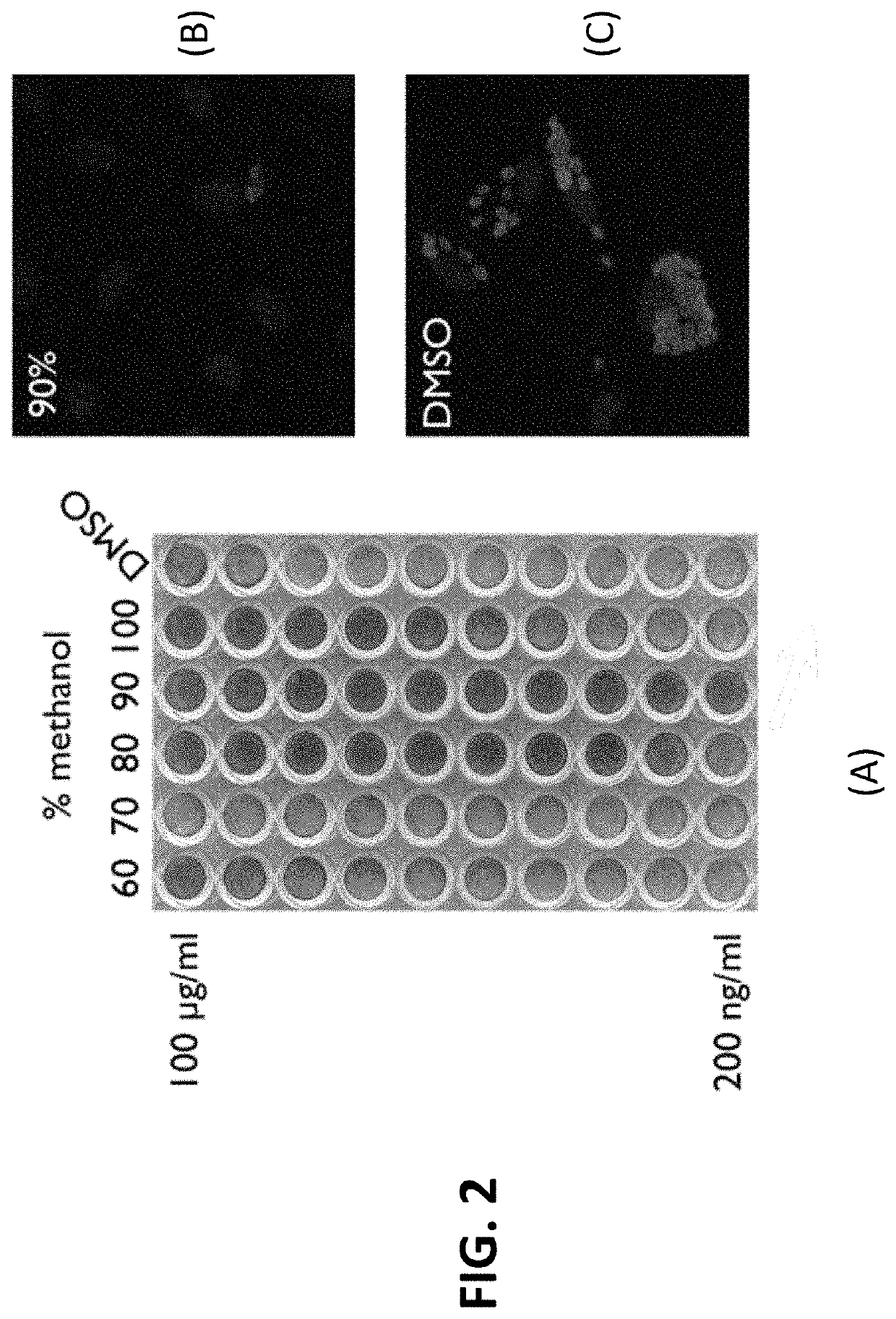Methods and compositions for prevention and treatment of Apicomplexan infections
a technology of apicomplexan infection and composition, which is applied in the field of methods and compositions for preventing and treating apicomplexan infections, can solve the problems of large economic losses of inflicted farms and no drugs available to cure cryptosporidiosis in immunocompromised patients
- Summary
- Abstract
- Description
- Claims
- Application Information
AI Technical Summary
Benefits of technology
Problems solved by technology
Method used
Image
Examples
example 2
ation of Tartrolon D / E as the Active Compounds in T7901 Cell Lysates
[0092]Approximately 1 liter of T7901 culture was grown under conditions that encouraged the formation of biofilms. To induce biofilm formation, bacteria were grown in test tubes in 3 mls of the complete SBM for 3 days, then the 3 ml bacterial culture was transferred to a larger flask that already contains 27 mls of complete SBM using sucrose as a carbon source. After 3-5 days of growth, this 30 ml culture was transferred to a 1 liter wide bottom flask already containing 170 mls of the complete SBM, bringing the total volume to 200 ml. The culture was allowed to grow for another 5-7 days. All cultures were grown at 30° C. while shaken at 35 rpm in experiments described here in the specification unless otherwise noted. The 200 ml culture was then transferred to multiple 50 ml tubes and centrifuged at 6000×g to separate the pellet and supernatant. Culture supernatant and cell pellets were collected and underwent bioass...
example 3
and Characterization of the Anti-Parasitic Agent
[0098]It was hypothesized that Tartrolon (see below) was the source of the anti-parasitic activity. To test this hypothesis, a cell pellet from the T7901 culture was extracted three times with acetone (100 mL). The solution was dried under vacuum to yield an extract (70 mg), which was dissolved in methanol (2 mL) and flushed through a cartridge containing end-capped C18 resin. The flow-through was purified by HPLC using 85% acetonitrile in water to obtain tartrolon D (1.7 mg). This compound was previously purified from the same bacterial strain, and its identity was confirmed by comparing data (HLPC chromatogram, mass spectrometry, and NMR, as shown in FIGS. 3A-3C, respectively) with previously reported data on tartrolon D (Elshahawi, et al., (2013), supra), namely: LC-ESIMS m / z 843 [M+Na]+, 866 [M+2Na]+ and UV λmax 231 nm (MeOH)).
[0099]Specifically in FIG. 3A, for instance, a Phenomenex Onyx Monolithic semiprep C18 column (100×10 mm) ...
example 4
on and Characterization of Tartrolon D
[0100]Growth of Teredinibacter turnerae with xylose as a carbon source at 35° C. followed by isolation of tartrolon D using a different purification protocol yielded a different preparation of tartrolon D (referred to as “tartrolon D2” hereinafter) separate from the one obtained (referred to as “tartrolon D1” for distinction) in Example 3.
[0101]The cultivation protocol for Tartrolon D2 was as follows: Bacteria from frozen stabilates were thawed and grown in 3 mls of SBM with 1% xylose as a carbon source. The bacteria were grown at 35° C. and at 35 rpm (standard growth conditions maintained throughout) for 48 hours or until there was significant growth as determined by the cloudiness of the media. These cultures were streaked out onto agar plates made with SBM containing 1% xylose and 1% Bacto agar. When individual bacterial colonies were seen, these were picked and each colony grown for 24-72 hours in 3 mls of SBM plus 1% xylose until growth was...
PUM
| Property | Measurement | Unit |
|---|---|---|
| weight | aaaaa | aaaaa |
| time | aaaaa | aaaaa |
| total volume | aaaaa | aaaaa |
Abstract
Description
Claims
Application Information
 Login to View More
Login to View More - R&D
- Intellectual Property
- Life Sciences
- Materials
- Tech Scout
- Unparalleled Data Quality
- Higher Quality Content
- 60% Fewer Hallucinations
Browse by: Latest US Patents, China's latest patents, Technical Efficacy Thesaurus, Application Domain, Technology Topic, Popular Technical Reports.
© 2025 PatSnap. All rights reserved.Legal|Privacy policy|Modern Slavery Act Transparency Statement|Sitemap|About US| Contact US: help@patsnap.com



